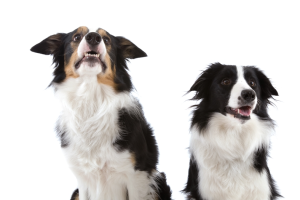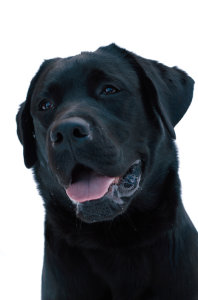 “Rover, come!” shouted in a high pitch excited voice is likely to get a faster and more enthusiastic response than the same words expressed in a monotone, low key fashion. Most trainers rely at least at certain times, on how they communicate with the dog to pump the excitement level up. The dogs are willing to work harder and faster and seem much more enthusiastic about the training session. But is building up the dog’s arousal level always beneficial? Could there be times when doing so may actually backfire and impair the dog’s ability to problem solve? A new study, led by a team of researchers at Duke University showed that depending on the dog’s emotional-reactivity, increasing her arousal may not be a good idea and could in fact negatively impact her performance when it comes to problem solving tasks (Bray & al., 2015).
“Rover, come!” shouted in a high pitch excited voice is likely to get a faster and more enthusiastic response than the same words expressed in a monotone, low key fashion. Most trainers rely at least at certain times, on how they communicate with the dog to pump the excitement level up. The dogs are willing to work harder and faster and seem much more enthusiastic about the training session. But is building up the dog’s arousal level always beneficial? Could there be times when doing so may actually backfire and impair the dog’s ability to problem solve? A new study, led by a team of researchers at Duke University showed that depending on the dog’s emotional-reactivity, increasing her arousal may not be a good idea and could in fact negatively impact her performance when it comes to problem solving tasks (Bray & al., 2015).
Arousal can be described as an increase in alertness, a state of heightened physical and mental activity. States of arousal can be either positive or negative. Anger, fear, curiosity, joy all describe different states of arousal. Some trainers might rely on inducing one emotion or another to increase the animal’s performance. As I’ve stated many times in previous blogs, I strongly discourage scaring an animal as part of training, so we’ll focus here only on inducing positive emotions.
According to the Yerkes-Dodson law (1908), when we increase the arousal level, we also increase performance. Studies on humans have shown that in most cases, stress hormones (glucocorticoids) help us respond to changes in the environment by increasing the availability of energy to different parts of our body. As our heart beats faster and our blood pressure increases, we’re now more vigilant and prepared for action. Arousal may also play a role in learning as emotionally arousing information is better memorized.
We’ve all experienced taking a test, speaking in front of a crowd, a job interview, an exciting game, etc. The increased arousal levels helps us perform, keeps us sharp and at the top of our game. Similarly, when dogs are aroused in a training session, they are more engaged, focused, interested and curious. They will learn faster and remember the task better. As a result, many trainers develop the habit of talking in an excited high pitch voice and work hard at keeping the training session exciting and fun for the dog. And it works…in most cases…
As the Yerkes-Dodson law goes, arousal increases performance, but only to a point. If the levels of arousal become too high, the performance levels drop. To complicate things even further, depending on the task, there could be differences in the levels of arousal needed for optimal performance. So if the dog needs stamina and speed, high levels of excitement may help, but if we’re working on a problem-solving task, just a low level of excitement may be best. Additionally, what the team of researchers at Duke University have found, is that based on their temperament, and more specifically on their excitability, different dogs will either perform better or worse with increased levels of arousal.

Two groups of dogs were compared in a detour task. To get to the food, the dogs had to go around an obstacle, a v-shaped transparent fence (see video below). Although the task seems simple, to reach the food placed right behind the transparent screen, the dogs had to first control their excitement and move away from the food and around the fence. In the low-arousal conditions, the person standing behind the fence and holding the food, called the dog in a low monotone voice. In the high-arousal conditions, the person behind the fence called the dog in a high-pitch excited voice while waving the food. The two groups of dogs tested had been chosen for their differences in baseline levels of arousal.
One group was comprised of dogs that had been bred and trained to become service dogs. Their levels of arousal were low. Hyperactive or excitable dogs are generally removed from service dog programs so only the dogs with a more laid-back temperament are bred. Cues are taught at a high level of fluency and stimulus control so in their training, the dogs are taught to inhibit certain impulses and wait for a command before going into action. The other group tested was composed of pet dogs. Although these dogs respond to human gestures, most don’t receive professional training, at least not to the level of service dogs. They naturally tend to be more reactive, more distracted and easily aroused compared to service dogs. Before and during the test, the arousal level of both groups of dogs was measured by how much they wagged their tail.
The results revealed a big difference between both groups of dogs even before the test. The service dogs wagged significantly less than the pet dogs. Just by walking around the testing room, the pet dogs were already at a higher level of arousal than were the service dogs. During the test, the service dogs performed better in the high-arousal condition, whereas pet dogs performed better in the low-arousal condition than in the high-arousal condition. Since service dogs are generally calmer than pet dogs, they didn’t get as excited by the high-pitch tone of voice of the person behind the fence and we’re able to work their way around. As predicted by the experimenters, the pet dogs did not perform well in the higher-arousal condition.
 When it comes to problem solving, people and dogs perform best at an intermediate level of arousal. If we’re not aroused enough or if we’re too excited, our ability to perform is impaired. What this study emphasis is that the overall level of arousal is not only influenced by the situation, the dogs already come with a certain level of emotion and/or stress. If we use our voice and body in the same way with every dog, we’re likely to send many over their threshold and impact their capacity to learn and problem solve. Arousal levels can be influenced by a number of factors such as breed, age, and individual temperament. Dogs with little ability to control their impulses are also shown to have reduced levels of serotonin, a neurotransmitter that is thought to affect behavioral inhibition, and increased levels of dopamine, a neurotransmitter involved in behavioral activation, reaction thresholds and sensitivity to rewards (Wright & al., 2012). In other words many pet dogs would learn and perform better when trained on tasks that involve problem solving, at reduced or intermediate levels of arousal. This effect was even more pronounced if they were described by their owners as being impulsive and excitable. Their brains simply cannot problem solve under high levels of arousal.
When it comes to problem solving, people and dogs perform best at an intermediate level of arousal. If we’re not aroused enough or if we’re too excited, our ability to perform is impaired. What this study emphasis is that the overall level of arousal is not only influenced by the situation, the dogs already come with a certain level of emotion and/or stress. If we use our voice and body in the same way with every dog, we’re likely to send many over their threshold and impact their capacity to learn and problem solve. Arousal levels can be influenced by a number of factors such as breed, age, and individual temperament. Dogs with little ability to control their impulses are also shown to have reduced levels of serotonin, a neurotransmitter that is thought to affect behavioral inhibition, and increased levels of dopamine, a neurotransmitter involved in behavioral activation, reaction thresholds and sensitivity to rewards (Wright & al., 2012). In other words many pet dogs would learn and perform better when trained on tasks that involve problem solving, at reduced or intermediate levels of arousal. This effect was even more pronounced if they were described by their owners as being impulsive and excitable. Their brains simply cannot problem solve under high levels of arousal.
 We can also think about what conditions we create for the dogs when they come to group classes. Many will be experiencing levels of stress and arousal higher than average due to the presence of the other dogs, the sounds, the novelty of the situation, the smells, etc. We’re expecting our students to learn new behaviors and focus on their handler (AKA owner most of the times). To help our students, both 2 and 4 legged, it might therefore be important to look for ways to keep the class as calm and low key as possible. Many use barriers to reduce the excitement from seeing the other dogs, but we also need to think about how we move and talk during the class, how much the dogs are barking, jumping, shutting down, yawning, etc.
We can also think about what conditions we create for the dogs when they come to group classes. Many will be experiencing levels of stress and arousal higher than average due to the presence of the other dogs, the sounds, the novelty of the situation, the smells, etc. We’re expecting our students to learn new behaviors and focus on their handler (AKA owner most of the times). To help our students, both 2 and 4 legged, it might therefore be important to look for ways to keep the class as calm and low key as possible. Many use barriers to reduce the excitement from seeing the other dogs, but we also need to think about how we move and talk during the class, how much the dogs are barking, jumping, shutting down, yawning, etc.
Although we like our dogs to be alert, focused and engaged in our training session, just like with most things in life, it’s a matter of degree. Too little or too much arousal can shut down Fido’s ability to think. Based on this latest study, we can only wonder if most pet dogs would benefit from reducing the excitement level, not increasing it. There are times when talking in an excited high-pitch tone can be effective, but in some cases, we might very well be hurting our training sessions.
Jennifer Cattet Ph.D.


Very useful information. Great.